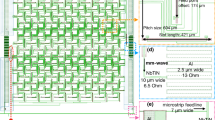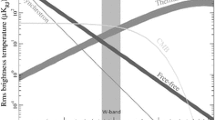Abstract
We present a multi-chroic kinetic inductance detector (KID) pixel design integrated with a broadband hierarchical phased-array antenna. Each low-frequency pixel consists of four high-frequency pixels. Four passbands are designed from 125 to 365 GHz according to the atmospheric windows. The lumped element KIDs consist of 100-nm thick AlMn inductors and Nb parallel plate capacitors with hydrogenated amorphous Si dielectric. Two different coupling structures are designed to couple millimeter-wave from microstrip lines to KIDs. The KID designs are optimized for a 10-m-class telescope at a high, dry site, for example, the Leighton Chajnantor Telescope. Preliminary measurement results using Al KIDs are discussed.
Similar content being viewed by others
Avoid common mistakes on your manuscript.
1 Introduction
Multi-chroic kinetic inductance detectors (KIDs) are an essential technology for future ground-based telescopes [1, 2]. Mapping speed, one of the key factors describing total power instruments, is mainly determined by the number of pixels. In the mm/sub-mm wave ranges, the optimal pixel size and spacing vary with frequency. For a multi-chroic pixel, where more than two bands exist, not all bands can achieve the best spacing, due to their identical pixel spacing. One way to solve this problem is to use a hierarchical focal plane array [3]. Here, we present a hierarchical pixel design using a slot-antenna array with KIDs. The long-term goal of this work is to make a hierarchical focal plane array covering 75-415 GHz with 6 bands [4], detailed in Table 1, for ground-based large telescopes, like the Leighton Chajnantor Telescope. As a technology demonstration, here we present a 2-scale design with 4 frequency bands from 125 to 365 GHz (Band 2-4) and preliminary measurement results.
2 Hierarchical Focal Plane Design
Resonant slot antenna array has been successfully used by the BICEP collaboration [6]. Compared to the resonant slot antenna, which has limited bandwidth, we follow the broadband non-resonant slot antenna design used in the MUSIC instrument [7, 8]. This design covers 75-415 GHz allowing 6 bands to be placed inside, shown in Fig. 1c.
To test the hierarchical concept, we made a 2-scale test pixel. The smallest antenna has a slot length of 3.33 mm for Band 3-5, and four small antennas are coherently added together to be a large pixel for Band 2 (Fig. 1b). The band separation is realized by 4 bandpass filters, grouped up as a network. The filter designs are modified from previous works [9, 10] and the performance of the network is shown in Fig. 1c.
a The concept of the ultimate hierarchical pixel design with 6 bands. b The mask of a 2-scale pixel design including 13 KIDs. c Antenna efficiency assuming a perfect anti-reflection layer. Transmission of the BPFs network are also plotted. The total coupling is the product of the two results. d The material stack-up
2.1 Millimeter-Wave Coupler
To couple millimeter-wave signal to KIDs, we designed two capacitive couplers shown in Fig. 2. Both couplers have a power divider to separate the signal into two microstrip lines. Those coupling pads next to the microstrip lines decrease their characteristic impedance, so the microstrip lines are narrowed for impedance matching. The vertical size of the inductor is 40 \(\mathrm {\mu m}\) and the horizontal size of the inductor is \(l_{abs}\) used in optimization. \(l_{abs}=1.5~\mathrm {mm}\) is used in the final design. Both couplers have the same inductor area and volume.
For low frequency bands (Band 1-3), the lossy AlMn inductor is designed to follow the signal traveling direction (Fig. 2b) as a lossy microstrip line and the coupling pads cover all the inductor area. For high frequency bands (Band 4-6), we let the inductor be perpendicular to the signal traveling direction (Fig. 2d) and coupling fingers are added on two sides of the inductor. A 180-degree phase shifter is used to alter the sign of the electromagnetic field, creating a voltage difference between the two coupling pads. The coupling strength is tuned by the area of the coupling fingers on the two sides of the inductor. With optimization, a near-uniform absorption is achieved in the inductor and the design is detailed in Ref. [5, 11].
2.2 Optimization of the AlMn KIDs Design
The thickness of AlMn is designed to be 100 nm with a transition temperature of 1 K, a sheet resistance of 0.069 \(\Omega \)/\(\Box \), and a sheet inductance of 0.11pH/\(\Box \). The 1 \(\upmu \)m-wide AlMn inductor has a magnetic inductance of 6.85nH/mm and the kinetic inductance ratio is 26%. Nb parallel plate capacitors with 800-nm thick aSi are used for tuning the resonance frequency.
To find the optimal KID design, we selected the horizontal inductor size \(l_{abs}\) (Fig. 2), and the resonance frequency \(f_r\) as sweeping parameters. The coupling quality factor is set to be the same with the internal quality factor \(Q_i\). The capacitor area is calculated from \(f_r\). We first calculate the noise equivalent power (NEP), and then use the mapping speed \(1/(\mathrm {NEP}^2\times \mathrm {Area})\), which takes the pixel area into account, to find the optimal design. \(Q_r>10^4\) is set to have a reasonable readout multiplexing factor. The optimization result of Band 2 is shown in Fig. 3. Taking the optimization results of 6 bands, we decide to have \(l_{abs}\)=1.5 mm. The inductor volume is 3224 \(\upmu \!\hbox {m}^3\) for all KIDs. Resonance frequencies from B1 to B6 are designed from 100 MHz to 400 MHz with 50 MHz span for each band. Some typical optimization results are shown in Table. 1. In this test pixel, B2-5 KIDs are used. A microstrip line is used for readout.
3 Dark and Blackbody Measurements of an Al Test Array
Al is used in our test device fabrication to verify the pixel concept. After fabrication, we performed one dark run and one blackbody run. 50 out of 56 KIDs are measured. By fitting the temperature sweep shown in Fig. 4, \(T_c=1.29\) K and \(\alpha =0.26\) are extracted, consistent with the values in design. The quasiparticle lifetime \(\tau _{qp}=\) 100 \(\upmu \)s, shorter than expected, is fitted from cosmic-ray events at 247 mK. Using this data, the maximum lifetime \(\tau _{max}={560}\,{\upmu \!\hbox {s}}\) is determined by including \(\tau _{max}\) in the quasiparticle lifetime calculation [12]. The dark NEP of 2.2e-17W/\(\sqrt{Hz}\) is calculated from the measured noise spectrum \(S_x\) using the following equation
where \(\varDelta \) is the gap energy, V is the inductor volume, and \(\eta _{pb}\) is the pair breaking efficiency taken from Ref. [13]. \(dx/dn_{qp}\) is derived from the measured resonance frequency shifts and the quasiparticle density calculated from the simplified Mattis-Bardeen equation [12].
In the blackbody run, the array was measured at 290 mK by sweeping the blackbody temperature from 4 K to 6 K. The quasiparticle generation-recombination noise was measured in phase direction from a dark resonator, shown in Fig. 4c. At this temperature, the thermal \(n_{qp}\) is very high and the possible quasiparticle density created by photons on this dark resonator is negligible. From fitting, the quasiparticle lifetime of 25 \(\upmu \!\hbox {s}\) and quasiparticle density of 2001/\(\upmu \!\hbox {m}^3\) are extracted, consistent with 25\(\upmu \)s and 2026/\(\upmu \!\hbox {m}^3\) calculated using the simplified Mattis-Bardeen theory [12].
Using the thermal \(dn_{qp}/dx\), the optical efficiency is estimated for each resonator, shown in Fig. 4d. It has been shown that the responsivities derived from thermal and optical methods may give a difference up to a factor of 2 [14]. In our high bath temperature case, the extra quasiparticles created by optical power are at the level of 200/\(\upmu \!\hbox {m}^3\), much smaller than the thermal one, so we suggest that this method can be used as an estimation of the optical efficiency. More rigorous results can be derived in a better experimental setup when the detectors are photon noise limited [15].
The Band 3 resonators show a higher efficiency than other bands, as the anti-reflection coating [16] is optimized for 170-300 GHz (-10 dB). In the next step, we will use Fourier transform spectrometer to detail the spectral characterization.
4 Conclusion
We have shown a new multi-chroic kinetic inductance detectors array design using broadband hierarchical phased-array antenna. Preliminary results from dark and blackbody measurements are analyzed. The overall optical efficiency is estimated. Further measurements are needed for beam characterization.
Data Availability Statement
The datasets generated during and analysed during the current study are available from the corresponding author on reasonable request.
References
P.K. Day, H.G. LeDuc, B.A. Mazin, A. Vayonakis, J. Zmuidzinas, Nature 425(6960), 817 (2003)
L. Perotto, N. Ponthieu, J. Macías-Pérez, R. Adam, P. Ade, P. André, A. Andrianasolo, H. Aussel, A. Beelen, A. Benoît et al., Astron. Astrophys. 637, A71 (2020)
A. Cukierman, A.T. Lee, C. Raum, A. Suzuki, B. Westbrook, Appl. Phys. Lett. 112(13), 132601 (2018)
G. Stacey, S. Golwala, C. Bradford, C. Dowell, G. Cortes-Medellin, T. Nikola, J. Zmuidzinas, T. Herter, S. Radford, J. Lloyd, et al., In Millimeter and Submillimeter Detectors and Instrumentation for Astronomy III, 6275, pages 463–474. SPIE (2006)
C. Ji,Design of Antenna-Coupled Lumped-Element Titanium Nitride KIDs for LongWavelength Multi-Band Continuum Imaging. Ph.D. thesis, California Institute of Technology (2015)
P.A. Ade, R. Aikin, M. Amiri, D. Barkats, S. Benton, C.A. Bischoff, J. Bock, J. Brevik, I. Buder, E. Bullock et al., Astrophys. J. 792(1), 62 (2014)
A. Goldin, J.J. Bock, J.J. Bock, A.E. Lange, A.E. Lange, H. LeDuc, A. Vayonakis, J. Zmuidzinas, Nuclear instruments and methods in physics research section a: accelerators. Spectrom. Detect. Assoc. Equip. 520(1–3), 390–392 (2004)
S. R. Golwala, C. Bockstiegel, S. Brugger, N. G. Czakon, P. K. Day, T. P. Downes, R. Duan, J. Gao, A. K. Gill, J. Glenn, M. I. Hollister, H. G. Leduc, P. R. Maloney, B. A. Mazin, S. G. McHugh, D. Miller, O. Noroozian, H. T. Nguyen, J. Sayers, J. A. Schlaerth, S. Siegel, A. K. Vayonakis, P. R. Wilson, and J. Zmuidzinas, In W. S. Holland, editor, SPIE Astronomical Telescopes + Instrumentation, page 845205. SPIE (2012)
S. Kumar, A. Vayonakis, H.G. LeDuc, P.K. Day, S. Golwala, J. Zmuidzinas, IEEE Trans. Appl. Supercond. 19(3), 924–929 (2009)
R. Duan, Instrumentation for Kinetic Inductance Detector Based Submillimeter Radio Astronomy. Ph.D. thesis (2014)
C. Ji, A. Beyer, S. Golwala, and J. Sayers, In Millimeter, Submillimeter, and Far-Infrared Detectors and Instrumentation for Astronomy VII, volume 9153, page 915321. International Society for Optics and Photonics (2014)
J. Zmuidzinas, Ann. Rev. Condens. Matter Phys. 3(1), 169–214 (2012)
T. Guruswamy, D. J. Goldie, and S. Withington, arXiv.org page arXiv:1602.06860 (2016)
R. Janssen, A. Endo, P. De Visser, T. Klapwijk, J. Baselmans, Appl. Phys. Lett. 105(19), 193504 (2014)
D. Flanigan, H. McCarrick, G. Jones, B.R. Johnson, M.H. Abitbol, P. Ade, D. Araujo, K. Bradford, R. Cantor, G. Che et al., Appl. Phys. Lett. 108(8), 083504 (2016)
F. Defrance, C. Jung-Kubiak, J. Sayers, J. Connors, C. deYoung, M. I. Hollister, H. Yoshida, G. Chattopadhyay, S. R. Golwala, and S. J. Radford, Appl. Opt. 57(18):5196–5209 (2018)
Acknowledgements
This work has been partially funded by Department of Energy DE-SC0018126 and NASA 80NSSC18K0385.
Author information
Authors and Affiliations
Corresponding author
Additional information
Publisher's Note
Springer Nature remains neutral with regard to jurisdictional claims in published maps and institutional affiliations.
Rights and permissions
Springer Nature or its licensor (e.g. a society or other partner) holds exclusive rights to this article under a publishing agreement with the author(s) or other rightsholder(s); author self-archiving of the accepted manuscript version of this article is solely governed by the terms of such publishing agreement and applicable law.
About this article
Cite this article
Shu, S., Beyer, A., Day, P. et al. A Multi-chroic Kinetic Inductance Detectors Array Using Hierarchical Phased Array Antenna. J Low Temp Phys 209, 330–336 (2022). https://doi.org/10.1007/s10909-022-02890-x
Received:
Accepted:
Published:
Issue Date:
DOI: https://doi.org/10.1007/s10909-022-02890-x








